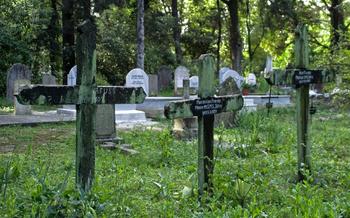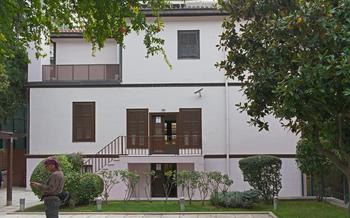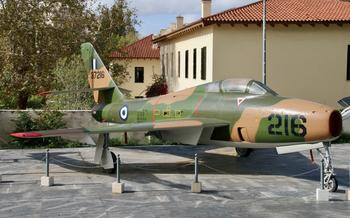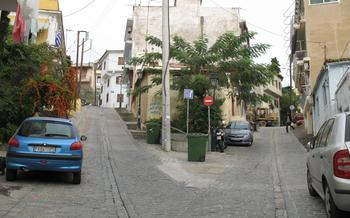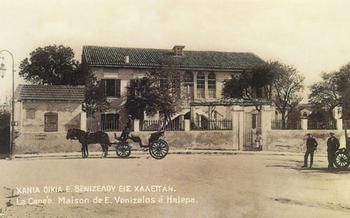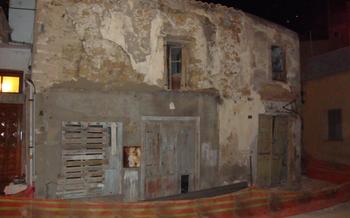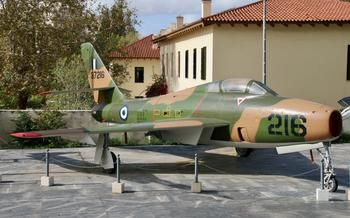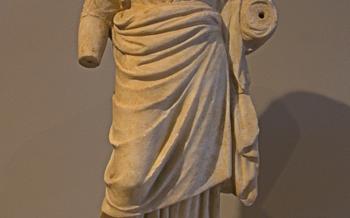
Zeitenlik Allied Cemetery
- A War Cemetery with a Profound History
- Location and Accessibility
- Layout and Design
- Diversity of Nationalities
- Graves and Epitaphs
- Honoring the Fallen
- Wartime Artifacts: Glimpsing the Past
- Ecological and Faunal Diversity
- Educational and Historical Value
- Cultural Significance
- Local Perspectives
- Visiting Hours and Practical Information
- Nearby Attractions
- Insider Tip: As you wander through the cemetery, take a moment to notice the intricate details etched into the headstones. Many of these stones feature unique symbols and carvings that represent the lives and personalities of the fallen soldiers. Look out for symbols of military service, religious beliefs, or personal passions, as these small details offer a glimpse into the individuals who rest here. By deciphering these hidden messages, you'll gain a deeper appreciation for the rich stories that the Zeitenlik Allied Cemetery holds.
A War Cemetery with a Profound History
The Zeitenlik Allied Cemetery, nestled in the heart of Thessaloniki, Greece, stands as a solemn testament to the sacrifices made by Allied soldiers during World War I. This hallowed ground bears witness to the pivotal role Greece played in the conflict, as it joined forces with the Allied Powers against the Central Powers.
The establishment of the cemetery in 1917 marked a somber chapter in Greece's history. As the war raged on, thousands of Allied soldiers, hailing from diverse nations, fell on Greek soil, their lives forever intertwined with the land they fought to defend. The cemetery became their final resting place, a place where their memory and sacrifice would be forever honored.
Each grave, each headstone, tells a story of courage, loss, and the ultimate price paid for freedom. The epitaphs, etched in stone, speak of young lives cut short, of families left behind, and of the unwavering spirit that drove these soldiers to fight for a cause greater than themselves.
Preserving and honoring the memory of those who lie beneath the soil of the Zeitenlik Allied Cemetery is not just a duty, but a privilege. Their sacrifice paved the way for the freedoms we enjoy today, and it is our responsibility to ensure that their stories are never forgotten.
Location and Accessibility
The Zeitenlik Allied Cemetery is situated in the city of Thessaloniki, Greece, at 541 23, Moni Lazariston. It is conveniently accessible by public transportation, with bus lines 1, 3, 5, 6, 10, 12, and 33 stopping nearby. Visitors can disembark at the "Zeitenlik" bus stop and follow the signs to reach the cemetery.
For those arriving by car, there is ample parking space available near the cemetery. However, it is important to note that parking restrictions may apply during certain times or events. Once inside the cemetery, visitors will find a well-maintained layout with clearly marked paths, making it easy to navigate and explore the grounds.
Layout and Design
The Zeitenlik Allied Cemetery is meticulously designed, reflecting the utmost respect and remembrance for the fallen soldiers. The cemetery is divided into several sections, each dedicated to a specific nationality. Within these sections, the graves are arranged in neat rows, creating a sense of order and symmetry.
Distinctive architectural features and monuments add to the cemetery's poignant atmosphere. The entrance is marked by an impressive stone archway, adorned with intricate carvings and inscriptions. Throughout the cemetery, visitors will find memorials and monuments honoring the fallen soldiers, each with its unique design and symbolism.
The landscaping of the cemetery is equally significant, contributing to its tranquil and serene ambiance. Cypress trees, known for their longevity and resilience, line the paths, providing shade and a sense of peace. Well-maintained gardens, adorned with colorful flowers, add a touch of beauty and tranquility to the surroundings.
The memorial walls and plaques within the cemetery hold a special significance. These walls are inscribed with the names of the fallen soldiers, ensuring that their memory lives on. The epitaphs on the headstones and markers tell the individual stories of these soldiers, offering visitors a glimpse into their lives and sacrifices.
Diversity of Nationalities
The Zeitenlik Allied Cemetery is a poignant reminder of the global nature of World War I. Soldiers from various Allied nations lie side by side, united in their sacrifice. Among them are men from the United Kingdom, France, Italy, Serbia, and Russia. Each of these soldiers had his own unique story, his own reasons for fighting, and his own family back home waiting for him.
The diversity of nationalities represented at the cemetery is a testament to the unity and camaraderie that existed among the Allied Forces during the war. These men came from different backgrounds, spoke different languages, and had different cultures. Yet they were able to put aside their differences and fight together for a common cause.
The Zeitenlik Allied Cemetery stands as a symbol of international remembrance. It reminds us that war is a global tragedy that affects people from all over the world. It also reminds us that even in the darkest of times, there is hope to be found in the unity and compassion of humanity.
Graves and Epitaphs
The graves at the Zeitenlik Allied Cemetery are a poignant reminder of the individual lives lost during World War I. Each headstone bears the name, rank, and regiment of the fallen soldier, along with a touching epitaph that tells their story. These inscriptions offer a glimpse into the lives and personalities of the men who fought and died for their country. Some epitaphs express the grief and sorrow of their families, while others celebrate the soldier's courage and sacrifice.
One particularly moving epitaph reads, "In loving memory of our dear son and brother, who died for his country. He was a kind and gentle soul, who will be forever missed." Another inscription simply states, "He died a hero's death." These heartfelt tributes serve as a reminder of the immense personal cost of war and the sacrifices made by those who fought in it.
The epitaphs at the Zeitenlik Allied Cemetery are not only historical records but also powerful expressions of emotion. They reveal the love, pride, and sorrow felt by the families and friends of the fallen soldiers. These inscriptions are a testament to the enduring memory of those who gave their lives in the service of their country.
Honoring the Fallen
The Zeitenlik Allied Cemetery is not just a place of remembrance but also a site where the fallen soldiers are honored and their sacrifices are commemorated. Throughout the year, various ceremonies and events are held at the cemetery to pay tribute to those who lost their lives during World War I. These ceremonies are not only attended by military personnel and government officials but also by local communities and organizations who come together to honor the fallen soldiers.
One of the most significant events is the annual Remembrance Day ceremony, held on November 11th. During this ceremony, wreaths are laid at the foot of the memorial cross, and prayers and hymns are recited to honor the fallen soldiers. The ceremony is a poignant reminder of the sacrifices made by these brave men and women and serves as a symbol of gratitude and respect.
In addition to the Remembrance Day ceremony, other events and commemorations are held throughout the year. These events include wreath-laying ceremonies by visiting dignitaries, educational programs for students, and exhibitions showcasing artifacts and documents related to the war. These initiatives help to keep the memory of the fallen soldiers alive and ensure that their stories are passed on to future generations.
Wartime Artifacts: Glimpsing the Past
The Zeitenlik Allied Cemetery is not merely a resting place for the fallen soldiers; it also serves as a repository of wartime artifacts that offer a tangible connection to the experiences of those who fought in World War I. Scattered throughout the cemetery grounds, visitors may encounter remnants of military equipment, personal belongings, and poignant mementos that evoke the human stories behind the headstones.
These artifacts range from helmets and rifles to badges, medals, and even trench art—handmade objects crafted by soldiers from discarded materials as a means of expressing their creativity and coping with the horrors of war. Each item holds a unique significance, providing a glimpse into the daily lives, hopes, and fears of the soldiers who once held them.
The presence of these wartime relics adds a profound layer to the visitor experience, allowing them to connect more deeply with the individuals who sacrificed their lives in the name of freedom. Museums and exhibitions within the cemetery showcase a curated collection of these artifacts, further enriching the understanding of World War I and its impact on the lives of those involved.
Preserving and interpreting these material remnants of the war is crucial for ensuring that the memory of the fallen soldiers remains alive. By safeguarding these artifacts and sharing their stories, the Zeitenlik Allied Cemetery serves as a testament to the resilience and sacrifice of those who fought on the Allied side during World War I.
Ecological and Faunal Diversity
The Zeitenlik Allied Cemetery is not just a place of remembrance but also a haven for wildlife. Set amidst lush greenery, the cemetery grounds are home to a diverse array of plant and animal species. Visitors can stroll along the paths and discover a variety of trees, shrubs, and flowers, including cypress, olive, and bougainvillea. The cemetery's tranquil environment provides a sanctuary for birds, butterflies, and other creatures, creating a harmonious blend of nature and history.
This ecological diversity adds another layer of significance to the cemetery. It serves as a reminder that life continues even in the aftermath of war, and that nature has the power to heal and restore. The presence of wildlife within the cemetery grounds symbolizes hope and renewal, reminding visitors that even in the darkest of times, there is always the possibility of growth and rebirth.
Educational and Historical Value
The Zeitenlik Allied Cemetery stands as a valuable educational resource, offering a profound insight into the realities of World War I. Guided tours led by knowledgeable historians bring the cemetery's stories to life, providing visitors with a deeper understanding of the sacrifices made by soldiers from various nations. Historical talks and presentations further enrich the educational experience, shedding light on the broader context of the war and its impact on Greece and the Allied Forces.
School visits to the cemetery are actively encouraged, as they provide an opportunity for students to engage with history in a tangible way. Educational programs designed specifically for younger audiences help them grasp the significance of the war and the importance of remembering those who fought and died. Through these initiatives, the cemetery becomes a living classroom, fostering a sense of empathy, understanding, and respect for the past.
Cultural Significance
The Zeitenlik Allied Cemetery holds significant cultural value and has been recognized by UNESCO as a cultural heritage site. It serves as a poignant reminder of the sacrifices made by Allied soldiers during World War I and fosters a profound sense of respect and remembrance. The cemetery promotes cross-cultural understanding and dialogue, bridging the gap between nations and fostering a spirit of reconciliation and peace. By preserving this historical site, we honor the legacy of those who fought for freedom and democracy, ensuring that their stories continue to inspire future generations. Furthermore, the cemetery's cultural significance extends beyond its historical value, as it serves as a symbol of unity and international cooperation, reminding us of the importance of working together to build a better world.
Local Perspectives
The Zeitenlik Allied Cemetery holds a significant place in the hearts of local residents, who view it as a symbol of remembrance and reconciliation. The community actively participates in maintaining and preserving the cemetery, ensuring that the memory of the fallen soldiers is honored and respected.
Local residents often share stories and anecdotes about the cemetery's history, passed down through generations. These stories provide a deeper understanding of the impact of World War I on the local community and the sacrifices made by the Allied soldiers.
Engaging with local residents offers visitors a unique perspective on the cemetery's cultural and historical significance. Their insights and experiences help visitors appreciate the cemetery not only as a memorial site but also as a place of profound emotional and historical resonance.
Visiting Hours and Practical Information
The Zeitenlik Allied Cemetery is open to the public throughout the year. Visiting hours vary depending on the season, so it's recommended to check the official website or contact the cemetery administration for the most up-to-date information. Admission to the cemetery is free of charge, allowing visitors from all backgrounds to pay their respects.
Facilities at the cemetery are limited, so visitors should come prepared. Restrooms are available near the entrance, and there are benches scattered throughout the grounds for those who wish to take a moment to reflect. A small visitor center provides basic information about the cemetery and its history, as well as brochures and maps to help visitors navigate the site.
Accessibility for visitors with disabilities is a priority at the Zeitenlik Allied Cemetery. Wheelchair-accessible paths lead throughout the grounds, and ramps are available at all entrances. Visitors with disabilities can also request assistance from the cemetery staff, who are always happy to help.
Nearby Attractions
Enrich your visit to the Zeitenlik Allied Cemetery by exploring the surrounding area, which is rich in historical and cultural attractions. Discover the vibrant city of Thessaloniki, with its iconic landmarks, museums, and bustling markets. Visit the Thessaloniki War Museum to gain a deeper understanding of the city's role in World War I and its aftermath. Explore the White Tower, a symbol of the city's resilience, and enjoy panoramic views from its rooftop. Immerse yourself in the vibrant atmosphere of Aristotelous Square, the heart of Thessaloniki, where you can relax in a cafe and soak up the local ambiance. Don't miss the opportunity to savor the delectable flavors of traditional Greek cuisine at one of the many tavernas and restaurants in the city. Whether you're interested in history, culture, or gastronomy, Thessaloniki and its surroundings offer a wealth of experiences for every traveler.

